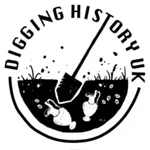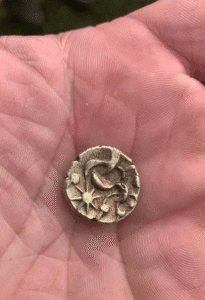Wigtoft Yields Its Secrets: A Day of Discovery 14th August
On 14th August, a brand-new 25-acre field at Wigtoft opened its gates to Digging History U.K. For many detectorists, it was the first chance to walk this untouched land, and the soil wasted no time in giving up its treasures. What followed was a day filled with history, camaraderie, and remarkable finds.
Silver of the Kings and Queens
The morning began with hammered silver. One of the earliest finds was a Henry III penny, lifted from the soil after lying hidden since the 1200s. The coin’s portrait still stared back across the centuries, a tangible link to a king who reigned during the building of Westminster Abbey.
Tim Sly, delighted with his discovery, shared:
“Nice hammered for me just before lunch. There’s more goodies to be had from that field once we’ve had a bit of rain.”
Later, Redvan Ric added to the regal tally with a stunning Elizabeth I sixpence dated 1579, alongside a jetton, a spur end, and other intriguing relics. These hammered coins once passed through the hands of merchants, farmers, and travellers in a very different Wigtoft.
Gems and Gold
The day’s showstopper was without doubt the gold ring unearthed by Glen Riley. Initially found with soil clinging to it, Glen later cleaned it up, revealing a delicate green stone still set proudly in its mount.
“A find I had on Thursday,” Glen said, “I’ve cleaned it up and it looked great.”
It’s not hard to imagine the story behind it – perhaps once worn as a token of love or faith, lost in the fields for centuries until Glen’s detector brought it back into the light.
Nearby, Martin Stokes’ group uncovered what appears to be a medieval mount still inlaid with striking purple and yellow stones – a reminder of the colour and splendour of jewellery in the past.
Everyday Life in the Past
Not every find was gold or silver, but each artefact told its own story. Fiona Gurney turned up a fascinating collection: part of a purse bar with inlaid decoration, a pipe tamper, a jaw harp, a book hinge, and coins ranging from a 1921 George V shilling to fragments still needing careful cleaning.
“Cracking day out,” Fiona said, “thanks Digging History U.K.”
Admin Martin Stokes praised her haul:
“Good work, Fiona! The purse bar stands out. The field was productive today, even in its current state, and it will be great once cultivated.”
Others added to the story of daily life through their finds:
Nikita Ivanovs uncovered a Royal Corps of Signals badge, a George III coin, and even a 1943 threepence.
Dean Bradley showed off his “better bits” – including two tiny pieces of silver alongside a George V penny.
Martin Stokes also highlighted the presence of young detectorists on the field – a great sign for the future of the hobby.
A Field That Keeps on Giving
By the end of the day, the range of finds was staggering – from Roman brooch fragments and medieval hammered silver, to Georgian tokens and 20th-century buttons. Each layer of history was represented, showing how Wigtoft has been lived in, worked, and walked across for thousands of years.
As the dig drew to a close, Martin summed it up perfectly:
“Plenty of signals and some lovely finds. Great to see several young detectorists.”
And in even better news, the new landowner was thrilled with the day’s results and has already invited the group back to explore another field – this one with an old footpath running the entire length. Who knows what further treasures await?
Wigtoft’s Story Lives On
From Roman jewellery to medieval coinage, from Tudor silver to Georgian tokens, Wigtoft’s new field has told stories that span centuries. Thanks to the enthusiasm and dedication of the Southlincs Searchers, these stories are no longer buried and forgotten – they live again in the hands of those who found them, and in the imaginations of all who hear about them.












